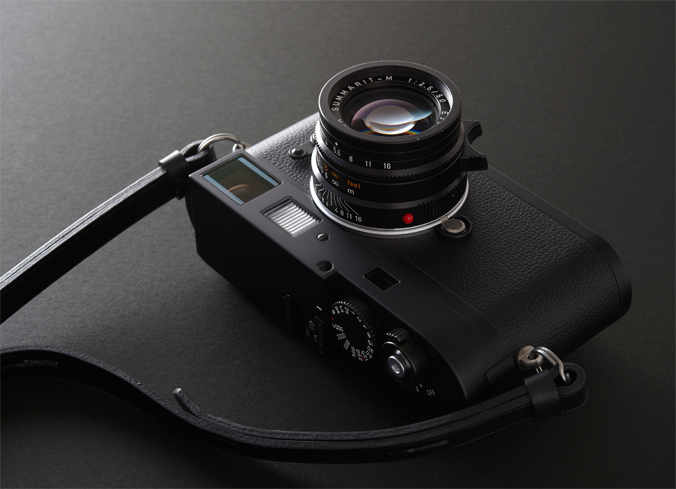
This is a digital camera that can only take black and white pictures. Many people would be puzzled to hear that and other people who like arts would be interested (until they see the price tag). Technologically proficient people should be fascinated and curious to see the output, while they are astonished by the fact such defiant camera has been released - Will it sell? Will I buy it?
As the enthusiasts know, the Leica M Monochrom isn't the camera produced just for the cheap black and white nostalgia. This is an ambitious camera that was produced after evidencing the advantage of discarding colors.
Discarding colors means that there is no need for combining color information based on the bayer filter array. Since each pixel on the CCD corresponds to one pixel in the output, it generates the native sharpness of 18 megapixels. The absence of color filter means you can take another veil off. This also means the raise in the base ISO (now 320), but those who know the advantage of lowpass-less sensor can easily expect the elevated performance of this camera.
Of course, you can expect higher resolution and precision from this sensor, but in fact the major advantages are richer tonality and wider dynamic range. Often, even a casual shot becomes your favorite shot once it has a rich gradation. Being affected by tonality is the moment when you go back to the fundamental joy of shooting black and white photography. I am sure that you will feel this high resolution and rich tonality once you use this camera.
However, you may say "I can convert my M9's color shots to black and white, so I don't need the Monochrom", and you're right - I think you can still get great pictures. Whether you get this camera or not is whether you can step into the camera that cannot take color photography. Think about this. When people are using films, once they installed a monochrome film, they had to keep shooting black and white pictures until they finish the roll. I know many people used to get a 100-foot roll of the Kodak Tri-X to reduce the cost, and just kept shooting. If you have the similar experience, why hesitate when you know that this is a Leica M camera loaded with a great monochrome film.
This camera was born because it's a Leica. This camera was made because there are Leica users.
( Photo : K & A.Inden / Text : M.Ishizuka )

One pixel on the sensor is responsible for one pixel in the output. The sensor of M Monochrom has an ability to depict a scene as minute as possible. The image on the right is a 100% crop of the one above. As you can see, each thread of the net is resolved faithfully. Now the old lenses that worked well with M8 or M9 are being tested because of this phenomenal sensor. And some of you may be a little disappointed with the results.
But I don't want you to misunderstand. The M Monochrom isn't the choosy camera. It just shows the potential of lens so directly, so the image shot with an excellent lens becomes astounding. And once you have seen such image, you naturally start to look for a lens that can meet what the sensor requires. In this sense, this is a camera that reconfirms how great the modern lenses are.


However, what appeals to me most is the rich tonality - a key factor for black and white photography because it is the factor that makes photographer most excited. The difference between the scene and what was photographed is something that only the photographer knows. Now, you can feel the difference on the LCD immediately after you shot, and that's just breathtaking. It's the monochrome world drawn with the gradient of black to white and it comes without graininess. What you just see on your LCD is a fine-art picture that was only available after so many processes with trials and errors: choosing a film, choosing exposure, temperature for developing, stirring the chemicals, and printing.
Just like when you shoot films, you can never be too nervous in selecting the exposure. RAW or JPEG, we can always adjust the output when we develop, but the best results are produced only after we shot with the best exposure at the scene.
The samples are shot in Germany and Czech Republic and I strongly feel that Leica is optimized to shoot in that place. Every shot I took with the hard light in Wetzler looks nice. Perhaps, you may want to raise the contrast a little when you shoot in Japan. Of course, you may also want to get a picture like an India-ink painting.


Because of the short flange back, there are many excellent and compact lenses for the Leica M mount. You don't have to worry about the color shift with ultra wide angle lenses, so the old lenses released in the monochrome age will perform at its best. It has higher base ISO than the M9, so using dark lenses won't be too much of an issue. After all, the advantages we got by discarding color are much greater than I expected.
This should be the best camera to enjoy the numerous old lenses including L-mount lenses. Shoot with an 80-year-old lens just like they did 80 years ago. Just chase light and shadow. Actually, we do that in color photography as well because it's the basic.
What does it mean to take photography? Why do you take photography? What do you want to photograph? If you focus on these things, the output doesn't always have to be in color. What you are looking for is a camera like this one.
Click to view other LEICA M MONOCHROM shooting reports > Vol.01 | Vol.02 | Vol.03 | Vol.04


LEICA M MONOCHROM
Active area approx. 23.9 × 35.8 mm, 5212 × 3468 pixels (18 megapixels). Infrared blocking filter for invisible light with wavelengths longer than 700 nm, no low-pass filter.
Selectable, DNG™: 5212 × 3468 (18 megapixels), JPEG: 5216 × 3472 (18 megapixels).
SD cards up to 2 GB, SDHC cards up to 32 GB.
At f/1.0/ISO 320/26°: EV 1 to 21.
The left triangular LED in the viewfinder blinks when light levels are outside the lower metering range.
ISO 320/26° to ISO 10000/41°, selectable in 1/3 ISO increments, in aperture priority automatic mode (A) and manual exposure setting, optional automatic control or manual selection. ISO 160 also available as a pull function.
0.68 x (for all lenses).
In aperture priority mode (A), continuous from 32 s to 1/4000 s. In manual mode, 8 s to 1/4000 s in half increments, B for time exposures up to max. 240 s, (1/180 s) shortest flash sync speed.